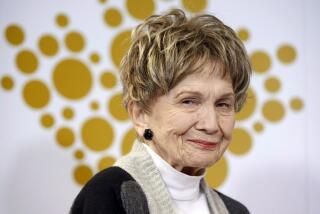Memories of ‘That Night’ : La Jolla Author’s Instincts Produce a Successful Novel
LA JOLLA — When Alice McDermott was writing the story that will someday become her third novel, she found herself resisting some stray notions that kept creeping into the work.
“I just found, as I was writing it, that there were some ideas coming into it that weren’t what the novel was about,” she recalled. “Some ideas about nostalgia, about memory. I was fighting to keep (them) out.”
Eventually McDermott gave in to the impulses, setting aside the still-unfinished third novel to explore her ideas about looking back. She chose an incident she had heard of while growing up in Elmont, a Long Island bedroom town near New York City, in which an argument between a young couple and the girl’s parents was played out before a watchful audience of neighbors on her street.
Followed Instinct
McDermott’s mother has since told her that she remembered the incident all wrong. But the instinct to write about it proved to be one of her better decisions. McDermott’s ruminations about what would happen before and after the public row became “That Night,” the second novel to win her high critical praise and a place on the front page of the New York Times Book Review. Published in April, the book is in its third printing.
Harper and Row has since agreed to print both “That Night” and McDermott’s first novel, “A Bigamist’s Daughter,” in paperback. In addition, 20th Century-Fox has purchased an option to turn “That Night” into a film and is negotiating with an “Academy Award-winning film maker” who was among half a dozen who wanted to handle the project, said Scott Rudin, president of production.
At 33, McDermott is destined “to be a major writer of her generation,” said her editor, Jonathan Galassi, executive editor at Farrar, Straus and Giroux, which published “That Night.”
“I think she’s a very, very smart writer,” Galassi said. “There’s an awful lot of things going on underneath the surface in whatever she’s writing. I just felt right away that her voice (was) very special and strong and clear, and was very different from other things that I had been reading.”
“That Night” revolves around an early 1960s love affair between two teen-agers, Sheryl and Rick. Sheryl’s father has recently died of a sudden heart attack. Rick is the troubled and hoodish son of an eccentric doctor and a schizophrenic mother. The story is told in retrospect by Sheryl’s now-adult neighbor, who witnessed the events as a 10-year-old.
Sheryl becomes pregnant, and, as was customary, is sent away for the duration of her pregnancy to relatives in Ohio. The night in question unfolds when Rick, unable to learn what has happened to Sheryl, blasts onto Sheryl’s quiet street with three carloads of leather-jacketed friends to rescue her.
He confronts Sheryl’s mother on the front steps of the home, and tosses her to the ground. A violent but simultaneously comical battle ensues between the neighborhood fathers, armed with hoes, baseball bats and garbage can lids, and the teens, who are packing chains.
McDermott takes the plot through the days before and after the fight, delving into Rick and Sheryl’s lives and the cocoon of suburban security that Rick and his friends shatter by invading the block.
“What distinguishes this novel from the mass of literature that takes on the barely middle-class suburban experience,” wrote novelist David Leavitt in the New York Times Book Review, “is the almost baroque richness of Ms. McDermott’s sentences, the intellectual complexity of her moral vision and the explicit emotion of her voice.
‘ “That Night’ gloriously rejects the notion that this betrayed and bankrupt world can be rendered only in the spare, impersonal prose that has become the standard of so much contemporary fiction, and the result is a slim novel of almost 19th-Century richness, a novel that celebrates the life of its suburban world at the same moment that it mourns that world’s failures and disappointments.”
Despite other reviews comparing her with Cheever and Updike as a chronicler of suburbia, the label is not one that McDermott wants. “A Bigamist’s Daughter” is largely set in Manhattan, but her third novel, about a family, also will be set in suburbia.
“I don’t feel I’ve set out to capture suburbia and defend it . . . ,” she said. “The characters are more interesting to me than the setting. The novel and what it has to say should transcend the setting.”
The characters and setting, while probably influenced by McDermott’s experiences and the people she has met, are not based specifically on anyone, she said. In fact, McDermott never thought of the street as being on Long Island until she read the book’s dust jacket, she said.
Nor does she care to be true to the incident. McDermott said she sets the plot in motion on her page, and then develops it in her imagination.
“My attitude toward research is, I will do it after the fact,” she said, partly to avoid the temptation to cram every fact she discovers into the novel.
‘Seeing What Happens’
“It’s just a matter of sitting down and writing about (the characters) and seeing what happens next,” she said. “In that way, it becomes more inevitable, because (the plot) has arisen from the writing. It’s not something that you’re trying to impose on the characters.”
For example, McDermott wished she could have provided a solution, a happy ending, for Rick and Sheryl. “I would have loved it,” she said. “I wish I could have pulled it off. But it just wouldn’t have been right.”
McDermott grew up in a working- to middle-class area of Long Island, attending Sacred Heart Academy in Hempstead, N.Y., where she usually found herself writing class skits and the like. With a state scholarship, she headed off to Oswego State University near Lake Ontario with no intentions of becoming a writer.
“I had no idea what I wanted to do,” she said. “I wanted to have a good time. And I wanted to get away so I didn’t have to come home too many weekends.”
Then, for an assignment in a nonfiction writing course, “I made up a story about a girl who went with a friend to an abortion clinic and watched her friend have an abortion,” she said. “And I had never been to an abortion clinic.”
Her professor, Paul Briand, praised her work and after class told her: “I’ve got bad news for you. You’re a writer.” (“That Night” is written in Briand’s memory.)
“I was thrilled,” McDermott said. “It was a revelation. It was the most wonderful thing. It was what I wanted someone to tell me.”
She still suggests that young writers today “take a nonfiction course and see what you can get away with.”
McDermott went on to get a master’s degree at the University of New Hampshire, where she met her mentor, novelist and faculty member Mark Smith.
“She is one of two students I have ever had . . . to whom I’ve said, ‘You’ve got it. Keep at this profession,’ ” Smith said.
In 1980, Smith sent McDermott to his New York agent, Harriet Wasserman, with a letter that said: “I’m going to send you a writer and you’re going to kiss my feet for sending her to you,” Wasserman said.
“Was he right? Indeed. I should kiss his feet,” said Wasserman, who represents, among others, Saul Bellow.
Focusing on Writing
Married in 1979 to neuroscientist David Armstrong, McDermott moved to Manhattan after graduate school and worked for a while at a “vanity” publishing firm, which, for a price, will publish any written work--a job featured in “A Bigamist’s Daughter.” She then settled down to nothing but writing, at home and during short writer-in-residence stints at three Eastern colleges.
She published “A Bigamist’s Daughter” in 1982. She and her husband moved to La Jolla in 1984 when he was appointed an assistant professor at UC San Diego Medical School. They have a 2 1/2-year-old son, William.
While working on the third novel, she is debating whether to attempt the screenplay for “That Night”--which she has not read for more than a year--should it become a movie.
“You are not simply putting it in different terms, you are telling a different story,” she said. “The story the novel tells could not be told on film.”
Despite the success of her first two novels and the predictions of critics and peers, McDermott professes not to be banking on such results in the future.
“It’s wonderful. It’s a relief. I know that there are so many fine books, well-written, that don’t get the attention they deserve,” she said. “I’m grateful that luck, in many ways, has gone my way.”
But she added, “I don’t take anything for granted. I don’t have any faith that because I’ve had (two) fairly easy, painless publications that the third is going to be the same. The third has to stand on its own.”
More to Read
Sign up for our Book Club newsletter
Get the latest news, events and more from the Los Angeles Times Book Club, and help us get L.A. reading and talking.
You may occasionally receive promotional content from the Los Angeles Times.






